On Saturday 30th June 1826, Richard Chadwick, eldest son of Richard Chadwick of Perryville, nephew of Mr. Wm. Chadwick, Sadlier Wells (now Kingswell) Tipperary was shot dead on the road-way, between the village of Bohernacrusha & the townsland of Rathcannon, in the parish of Holycross, at a point where a bridge now crosses the railway tracks, which was later erected around 1847.
The body of Mr Chadwick was later buried in Cullen, Co Tipperary.
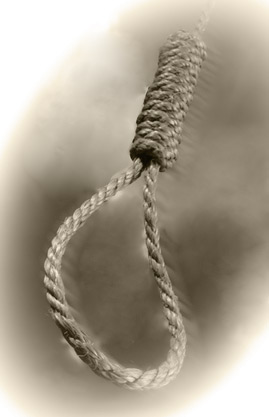 Mr Chadwick (aged 25) was Weighmaster (A licensed public official who verifies the true weight of various goods) in Tipperary & was employed by his uncle as land agent, in charge of the townsland of Rathcannon. He had previously evicted a number of the tenants on this estate & had served ‘notices to quit,’ on the remainder. A presentment to erect a police barrack at Rathcannon, (Now a Hand Ball Alley,) having been passed by the Grand Jury on June 29th, saw Chadwick visiting the district to arranged to have the foundations of this barrack building laid down. He stayed overnight with Mr. Armstrong at Farney Castle, & on the following morning proceeded on horseback to Rathcannon to oversee his men to work. He had engaged four masons named Mara, natives of Pouldine, in Moycarky parish, to erect the building & had ordered the remaining tenants on the estate to assist with the erection.
Mr Chadwick (aged 25) was Weighmaster (A licensed public official who verifies the true weight of various goods) in Tipperary & was employed by his uncle as land agent, in charge of the townsland of Rathcannon. He had previously evicted a number of the tenants on this estate & had served ‘notices to quit,’ on the remainder. A presentment to erect a police barrack at Rathcannon, (Now a Hand Ball Alley,) having been passed by the Grand Jury on June 29th, saw Chadwick visiting the district to arranged to have the foundations of this barrack building laid down. He stayed overnight with Mr. Armstrong at Farney Castle, & on the following morning proceeded on horseback to Rathcannon to oversee his men to work. He had engaged four masons named Mara, natives of Pouldine, in Moycarky parish, to erect the building & had ordered the remaining tenants on the estate to assist with the erection.
About mid-day, leading his horse, accompanied by Philip Mara, Chadwick was proceeding towards Holycross, when at the point already referred too, an armed man stepped out from the fence on the left side of the road. Raising a gun, he ordered Mr Chadwick to give himself up. Philip Mara endeavoured to remonstrate with the assailant, whereupon the man raised his gun & emptied the contents into Chadwick’s body, killing him instantly.
In the meantime another man, also armed, appeared from the opposite side of the road, but took no active part in the proceedings. The man who fired the fatal shot was Mr Paddy Grace, a native of Ballytarsna, born close to the now castle. Grace was well known as a daring individual who had already a record in deeds of violence, blood-shed & robbery. The second man was Mr Lawerence Barry from an area close to this scene & known as The Hough.
When the first shot was fired, Philip Mara turned & ran back towards the barrack. Hearing a second shot, he looked back & saw Paddy Grace standing over the body, searching the pockets of his fallen victim. In the search, Grace had found a pistol & possibly seeing some faint twitch of life in his victim, emptied the contents of this pistol into Chadwick’s brain, through his right eye. Mara continued running & first informed Rev. Mr. Lloyd before then travelling to Thurles to inform the police, telling Capt. Wilson, the then Police Inspector, that he had recognised Paddy Grace as the assassin.
On Chadwick’s body, Grace had found some notes ‘endorsed,’ which on his later arrest, were found in his possession. Now identified by Mara, Paddy Grace was arraigned at Clonmel Assize in July 1827 & convicted of the capital offence on Friday the 17th of August. He was later hanged at Rathcannon on Monday the 20th August 1827, having admitted his guilt on the gallows & exhorted his brothers and others in attendance, to desist from unlawful practises. Barry was also arrested & put on trail, but Philip Mara, not being unable to confidently identify him, he was acquitted.
Shortly after Grace’s execution, work was resumed on the barrack by Philip Mara’s brothers, Lawerence, Timothy & Daniel & an apprentice named Hickey.
In the meantime, Piery Grace, a younger brother of Paddy, was actively engaged in procuring a number of desperadoes from various parts of the country. His intention was to murder Philip Mara’s three brothers. Going to Golden he enlisted the services of Thos. Fitzgerald, Patrick Lacy, Edmond Ryan & one, an individual named Kirby, from Donaskeagh. Others involved in the conspiracy were Edmond Ryan of Ballymoreen, John Walsh, Tom Keogh & his sons Patrick & John, Micheal Treacy, Watt Grace, John Daniel, Micheal Luby, & Thomas & Darby Bryan. According to the evidence at subsequent trials, the conspirators assembled at Tom Keogh’s in Rathcannon on the 23rd September 1827, & arranged to intercept the Mara brothers, on their return from work on the barrack.
On the following morning, Fitzgerald, Watt Grace, Edm. Ryan of Ballymoreen, & Lacy took up position in the Grove at Rathcannon, and awaited the arrival of others. However a gun was accidentally fired during this meeting, which warned the Mara brothers, latter who duly decided to leave off work for some days. Informed some days later that the Mara’s were again at work, a number of the conspirators again assembled in the Grove & were supplied with whiskey & bread by Kate Costello, a servant & relative of the Keogh’s. However that evening the Mara’s left off work earlier than usual, before the conspirators reached the road.
The following day, the Maras were not at work, but the next day, the 1st of October 1827, when the Mara’s left off work, the evening being wet, Fitzgerald, Kirby, the two Edm. Ryans, Walsh, Wat. Grace, Lacy and Bryan were ranged inside the fence of the roadside and fired on them without effect. Armed with pistols, the Mara’s returned the fire and broke away, with Lawrence and Timothy taking to the fields, and escaping. Daniel Mara kept to the road and ran through the village of Bohernacrusha, pursued by the whole party, till he reached the house of Ned Kennedy, situated about 100 yards from the village, on the right side of the road leading to Holycross.
On entering the house, he requested a young girl, Peggy Kennedy, to close and bar the door, which was done. Finding the door barred, Ryan of Golden tried to leap through the window but was struck from inside by Mara with a ‘Gridiron.’ (Latter a utensil of parallel metal bars, used to grill meat or fish.)
Later the door was forced, and Kirby, Walsh and Bryan entered. One of them knocked Mara down with the stock of a gun. Lacy then entered and fired at the prostrate man, killing him instantaneously. Lacy re-loaded his gun and the party being given whiskey by Watt. Grace, & departed. Four of the party proceeded to the house of John Russell at Curraheen, where they obtained food and remained there for some days.
At the March Assizes of 1828, Patrick Lacy and John Walsh were tried for murder and convicted, the principal witnesses for the Crown being their accomplices, Thos. Fitzgerald and Edm. Ryan of Ballymoreen. The trial concluded at 4.00p.m. on Tuesday April 1st, and at noon on Thursday April 3rd, they were both hanged in front of Clonmel Jail.
After Paddy Grace was executed at the scene of Chadwick’s murder, his body was taken to Cashel infirmary for dissection. Despite his brother’s exhortation from the gallows, Piery Grace vowed vengeance on the Maras & determined to exterminate the whole family. Philip Mara, knowing that he was a marked man, granted possession of his farm to his brothers & fled to England, even before Paddy Grace’s execution was carried out. Piery gathered an armed gang who had no connection with the district, to carry out the massacre & planned that he and 9 other conspirators in the district would be far away from the area, when their business was completed & so provide cast-iron alibis. When Dan Mara took refuge at Kennedy’s, Peggy Kennedy went up to a loft and hid under a bed there for refuge. Mara begged for mercy, but was knocked to the ground & shot dead.
About a quarter of an hour after the gang departed, Peggy Kennedy crept down to find Mara’s dead body on the kitchen floor. Several persons were arrested & the Solicitor-General came down from Dublin for to conduct a special investigation, but those arrested had to be released for lack of evidence. A man named Long was detained however & bought to Dublin. A newspaper report stated that one of the Mara brothers went for safety to Borrisokane, Tipperary, but when at Mass there, some 5 armed men cut his horse’s throat & would have shot Mara, present in the church, had not the local priest intervened. A brood mare, owned by John Bourke of Barnalisheen (Moyne,) who was married to a sister of the Mara brothers, was ripped open & killed. John Burke, fearing for his life, immediately left the country. An attempt to murder their apprentice Hickey was also attempted & a man who had married a relative of the Mara brothers was ordered to send her away, which he duly did.
The authorities moved to get the remaining Mara brothers out of the country for their own safety. On Saturday the 20th of October, the Earl of Llandaff & 50 other Magistrates met at Cashel & sent a ‘Memorial,’ to the Lord Lieutenant to re-enact the Insurrection Act & revise the Arms Act. (Insurrection Act: Justices assembled in consequence, not being fewer than Seven in a County at large, or than Three in a County in a Town or City, or the major part of such Justices respectively, shall and may, if they shall see fit, upon due Consideration of the State of the County, signify, by Memorial, signed by them, to the Lord Lieutenant, or other Chief Governor or Governors of Ireland for the time being, that they consider their County, or any Part thereof, to be in a State of Disturbance…) He, however, ordered an augmentation of the police force in Co. Tipperary & a vigorous prosecution of all or by any means to bring perpetrators of these foul deeds to justice, hoping the Magistrates would wholeheartedly co-operate. A £2,000 reward was offered for information.
Meanwhile, Thos. Fitzgerald was caught red-handed in an armed robbery near Killenaule, Tipperary & was lodged in Clonmel jail. To save himself he turned informer, stating he was a son of old Garrett Fitzgerald, who lived with a farmer named Heffernan at Kilballyherbery.
Crown Evidence Against Paddy Grace
(1) Identification by Philip Mara. In cross-examination by Mr. Hatchell for the defence, Mara admitted that he was a tenant of Sadlier on 20 acres of land & had been hard driven for the rent. Within the previous 12 months, his cattle were seized by the landlord, & to release them he had to borrow money & he told a man named Heffernan, that he hoped it was the last time he would ever have to pay Chadwick. He denied that his haste in reporting the identification of Grace was the fear that he would be implicated in the crime or that the identification of Grace was a convenient figment of his imagination.
(2) The money that was taken from Chadwick was in part, some money Chadwick had received for rent at Sadlier’s Wells, before leaving Tipperary town, from brothers James & Philip Ryan. Chadwick, as was his custom, endorsed the notes received with the names of the payees & with his own initials. Malachy Niel, Chadwick’s bailiff, gave evidence that Chadwick took these notes with him to pay for a horse he had brought near Rathcannon. One of the notes was found on Paddy Grace in the Bridwell, Cashel, after Grace’s sister Mary, had come to visit him there.
The Defence.
(1) Edmond Kelly told the court that after a funeral last Christmas, he had heard Phil Mara, say that his rent payment was refused, as he was £5 short, that the Rathcannon tenants would not prosper while Chadwick collected the rents & the best thing was to put an end to his life, so that he would not terrorise any tenants again. On cross-examination, he admitted that he was recently released from jail & had spent 3 months on the Clonmel Thread-Mill, & that Grace was then there also, but denied he had discussed what evidence he would give; he also denied that he was suggesting that Mara committed the murder.
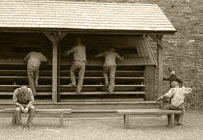 ( Note: Thread -Mills were invented in 1817 by Sir William Cubit, who observed prisoners lying around in idleness and put himself to the task of “Reforming offenders by teaching them the habits of industry.” His idea was adopted as a form of hard labour that could also grind grain or pump prison water. On Saturday 11th May 1839, a ruffian named Pierce Treacy of nearby Ballycahill village was sent for two months to the thread-mill by Mr Tabiteau C.M. for flinging a stone at Mr. B. Ryan, Manager of Thurles Agricultural Bank.)
( Note: Thread -Mills were invented in 1817 by Sir William Cubit, who observed prisoners lying around in idleness and put himself to the task of “Reforming offenders by teaching them the habits of industry.” His idea was adopted as a form of hard labour that could also grind grain or pump prison water. On Saturday 11th May 1839, a ruffian named Pierce Treacy of nearby Ballycahill village was sent for two months to the thread-mill by Mr Tabiteau C.M. for flinging a stone at Mr. B. Ryan, Manager of Thurles Agricultural Bank.)
(2) Ml. Ryan & his brother-in-law, Wm. Burke, said they were cutting soil on river bank at Rathcannon when they heard shots & two men with arms ran past them, threatening them not to tell the police. Neither of the men was Grace, whom they knew. John Grace, brother of Paddy, swore that both were trenching potatoes at Ballypatrick at the time of the murders, but gave no explanation as to why he did not tell this to the authorities when his brother was arrested, or since then. The jury returned a verdict of guilty after a quarter of an hour’s retirement. Paddy Grace was led from Clonmel jail at 5.00am, bound on a common cart, surrounded by a company of the 58th Regiment, and they set out for Rathcannon. (The Kilkenny Independent Wednesday, August 22, 1827: Captain Leyne and Mr. Cruise of the 58th Regt. marched on yesterday with a detachment of that distinguished corps, to occupy the Cashel Barracks. We understand that the 58th Regt. have been highly esteemed and complimented during their stay in Dublin. Since their arrival here, nothing can exceed the gentlemanly demeanour of the Officers, and excellent discipline and good conduct of their men.) They were met on the road by numbers of people & gentlemen on horseback. Fr. E. Brennan attended the prisoner. They stopped for food at Cashel.
Thos. Fitzgerald Son Of Garrett Fitzgerald Turns Informer
Thos. Fitzgerald was described as a desperado who went round the Country armed robbing and intimidating victims and was ready to give his services in any lawless enterprise. He belonged to an outlaw gang called “Night Walkers.” His statement is as follows:-
Went with an associate, Patrick Lacy, a well-to-do young farmer, of a “stout and of forbidding countenance” to Heffernan’s of Kilballyherby one night last September. They hid their guns after which Fitzgerald’s father let them in to sleep. They departed before dawn the next morning to Ned Coady’s, an orchard-keeper residing at Rathclough. Coady hid their guns and they went to Tom Maher’s of Brick Hill, near Cashel. On the way, they met Fitzgerald’s father at the crossroads of New Park, with a horse and car. He gave them a lift to near Brick House.
Maher was still in bed when they arrived, but a servant girl, Mary Dunn, gave them their breakfast of potatoes and milk. The girl then left for Cashel with a consignment of new milk. They were making a gap with Maher, when Piery Grace arrived and discussed making up a party to take revenge on the Mara brothers. Maher urged Fitzgerald to join up, saying that he would go himself, but he had a sore leg. Grace said there would be 15 or 16 in the party. He confirmed that Ned Nagle of Golden was asked to join it, and Ger Lonergan would also be with them “if he had not taken away a girl.”
After fetching the guns and having dinner at Mahers, Grace, Lacy and Fitzgerald set out for Rathcannon. They saw on the way the Bergin boys and girls stacking corn at Knockbue; saw Pat Mahony on the Dublin Road, and met Gleeson, the wood-ranger of Col. Pennefather, going towards Cashel. The party turned off near Pat Costello’s house and came across to Ballysheehan churchyard and arrived at Ballytarsna, where Bill Grace, father of Piery resided.
On the direction of Piery, Lacy and Fitzgerald stopped in a nearby fort, while Piery went into the house. At the fort, they found Mary and Kitty Grace picking potatoes. The ladies upbraided Lacy for his absence from their brothers execution and he claimed he did not hear about it till a fortnight later. Piery Grace came along with two men and directed them all to make haste to Rathcannon.
On the way they met Tom Scanlon and his boy filling corn, and further on Pierce Grace, a relative of Piery, and then they met men named Ryan and Dwyer. They also saw the Phenisees (Fennessy’s) in a haggard. They crossed the Suir and made for Tom Keogh’s near Rathcannon, who had two sons John and Patt. Two strange men in their company did not come further than Holycross. John Keogh, Patt Keogh and John Walsh met them and said “It was murder that the party were not up a little sooner as the Mara brothers had just passed by.”
Fitzgerald later found out that the two strange men were Looby and Daniel. The Keogh’s showed Lacy and Fitzgerald the store of arms hidden in a grove. After dark they went into Keogh’s barn, as Keogh didn’t want his workman to see them. When Keogh was gone to bed they went into the house and found there, Ned Ryan of Ballymoreen and Darby Bryan of Thurles. Kate Costello the servant, gave them a supper of potatoes & milk & they went to bed.
Next morning, Piery Grace said he was going to the fair of Cahir, so as to have an alibi. The Mara’s did not come to work on Tuesday or Wednesday, because of a delay in a supply of scaffolding & they told this to Grace, who had just returned from Cahir. Then with Watt Grace, brother of Piery, they returned to Keogh’s for the night & got a glass of whisky each. At daybreak, Ned Ryan, Lacy, Piery Grace & Fitzgerald went to the grove & Kate Costello bought them bread. They later heard that the Mara’s would not be at work that day. So Jack Keogh gave them 2 glasses of whiskey each & they went off to Killough Hill.
Fitzgerald fired at a person who was looking at them, to frighten him. Theyagain met the Fennessy’s & an old man, John Stokes, who had given Fitzgerald “sauciness” previously. Stokes was put on his knees & they threatened to be shot him. They also met Mr. John Phillips of Gaile & a boy named Fahey. They went to the house of old Jack Russell of Curragheen & saw Mary & Peggy Russell there, with an old woman (Peg Russell) & her son Davy & also Tim Ryan.
They then crossed the Bog of Allen & stayed on an island there called Garryclogh & at other different houses in the neighbourhood. On Saturday they gathered at Croke’s & danced to the music of a tambourine, drum & fife. On Monday night they attacked the house of one named Egan, near Lanespark & took a gun & clothing. They got back to old Jack Russell’s on Tuesday morning, the 25th & crossed over to Ballytarsna. They heard that the Mara brothers had resumed work & went to the grove, waiting until midday, but their intended victims did not turn up, so they went back to Ballytarsna.
Next day, Lacy went over to Russells & came back with news that the Mara’s were at work, so Ned Ryan of Ballymoreen, Lacy & Fitzgerald set out for Rathcannon. They were joined by Ned Ryan of Golden. They came to Keogh’s before daybreak & Pat Keogh brought them to where he had hidden guns. Joined by Darby Bryan & as the day was wet & cold, Lacey brought a bottle of whiskey from Keogh’s & Kate Costello supplied them with barley bread & butter. They hid in the grove & were joined there by Watt Grace, Jack Walsh & Ml. Treacy who brought powder. Pat Keogh was there about 2.00 o’c & said he was going to Thurles to buy a pair of shoes. Jack & Tom Grace were there also & said they were going to the forge with horses to have witnesses, if arrested. James Kirby came an hour before the attack.
Now eight men were now on hand for the attack. They hid where Chadwick was murdered & but as this area was too exposed, they moved towards Bohernacrusha, to a place covered with Sally trees.
When the Mara brothers arrived Ned Ryan of Golden fired first & then 3 others also fired shots. The Mara’s ran in different directions, eluding their attackers. Watt Grace & Fitzgerald with Ned Ryan of Ballymoreen went to the Widow Kennedy’s, warning the people of Bohernacrusha to keep under cover in their homes. At Kennedy’s, Fitzgerald saw Ned Ryan of Golden try to leap in the window, but failed. He got in on a second attempt. Then the door was broken down. Kirby leaped in, followed by Jack Walsh, Lacy & Darby Bryan. After shooting Dan Mara, the party overtook the main party near the Suir & got a glass of whiskey each from Watt Grace at Scanlan’s ground. They then went to Daniel Kerwick’s near Grallagh. Darby Bryan, Ned Ryan, Lacy & Fitzgerald then went to Jack Russell’s of Curragheen. Old Jack & old Peg Russell were greatly dissatisfied with the result of the mission, but they were given supper & whiskey there.
Sixteen were arrested & charged with murder or ‘conspiracy to do so.’ Ned Ryan of Ballymoreen denied having anything to do with the plot, but confronted with Fitzpatrick’s information he too also turned Crown evidence & identified Lacy as the man who actually shot Dan Mara. Kate Costello also gave Crown’s evidence & broke down at the trial & was carried out after giving her evidence, to be attended by a doctor.
Pat Lacy & John Walsh were the first two put on trial, Lacy for shooting Dan Mara & Walsh for aiding & abetting. With all the witnesses the Crown had to corroborate Fitzgerald’s information & there was no trouble in securing a conviction. An alibi was advanced in Walsh’s case without effect. Fitzgerald was most flippant in giving evidence & while admitting his life of crime he also announcing he expected the ‘blood money,’ to be promptly paid, as he had earned it. Lacy & Walsh were described as well to do farmers. Great precautions were taken to guard the prisoners. A detachment of Scots Greys were brought from Cahir, besides the mounted police presence.
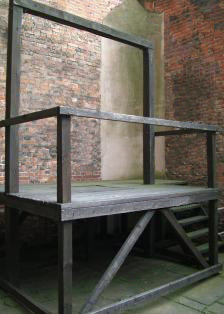 Conviction came at 4.00p.m. on Tuesday 1st April 1828, & the two prisoners attended by a priest were lodged in Clonmel jail. They were brought to the gallows at 12.00 noon, Thursday 3rd, with Lacy attended by Fr. Baldwin, who kept saying prayers with him, unmindful of the shrieks & wails of his relatives. Walsh was attended by Fr. Brennan & called on the assembled multitude to pray for his soul. Both hanged together in front of Clonmel Jail. Their bodies were sent to the County Infirmary, Cashel, under a military guard, for dissection.
Conviction came at 4.00p.m. on Tuesday 1st April 1828, & the two prisoners attended by a priest were lodged in Clonmel jail. They were brought to the gallows at 12.00 noon, Thursday 3rd, with Lacy attended by Fr. Baldwin, who kept saying prayers with him, unmindful of the shrieks & wails of his relatives. Walsh was attended by Fr. Brennan & called on the assembled multitude to pray for his soul. Both hanged together in front of Clonmel Jail. Their bodies were sent to the County Infirmary, Cashel, under a military guard, for dissection.
Among those who gave evidence at the trials were:- Thos. Fitzgerald, the informer, & Garrett his father, a workman at Kilballyharbery; Ned Cody of Rathclough; Mgt. & James Bergin, Knockbue; Ml. Gleeson, Ballytarsna; John Dwyer, Wm. Ryan & Mark Kelly, Killough Hill; Edm. Ryan, Ballymoreen; Kate Costello, living at Tom Keogh’s Rathcannon; Dr. Rd. Forsythe, medical evidence; Tim Mara; Hickey; Peggy Kennedy.
The next pair to be put on trial were Patt & Jack Keogh, sons of Tom Keogh, of near Rathcannon. Patt & Jack Keogh were executed on the 10th of April 1828. They were described as farmers of property & substance, men of repute & respectability. They were well dressed & Jack Keogh in particular was a fine looking man. At the trial the prosecutor said they were friends & neighbours of the Mara’s.
When police at Holycross heard the shots, they went to the Widow Kennedy’s house & found the dead body of Daniel Mara. They proceeded to Keogh’s house & found Jack & Thomas Keogh, who had returned from the Forge, sitting at the fire, one mending his shoe. Sergeant Carr interrogated them, who defied him to prove anything against them & at a later questioning, Thos. & John Keogh said they had witnesses to prove they were at the forge with a horse & Patt Keogh said he was in Thurles that day & slept there that night.
The Crown’s case was substantially the same as at previous trial of Lacy & Walsh. The defence called Denis Ryan, the Blacksmith, and John Maher to prove that John and Tom Keogh were at the forge, when intimation of the murder reached that place. Michael Finn, publican, gave evidence that Pat Keogh was in Thurles that day and slept there that night. At 11:30 p.m. on Saturday (5th April) the jury retired. The prisoners in meantime appeared to be deeply agitated. Patt Keogh in particular looked wildly about, throwing fearsome glances at the jury room. At 12.00p.m. the jury returned with a verdict of guilty. As it was now Sunday morning, sentence was postponed till Monday and the prisoners were removed to their cells accompanied by a priest. Before leaving the dock, John Keogh threw his arms around his wretched father. On Monday morning, the judge, spoke of the enormity of their crime in murdering a man, who had come forward in defence of the law. He then urged them, who had made a sacrifice of human life to make a sacrifice to God of a humble and contrite heart. He then passed the sentence of death and fixed Thursday for execution. They were allowed a visit by their afflicted parents. At 12:30p.m. on Thursday, they were led out to the gallows, Patrick attended by Fr. Gaffrey and Jack by Fr. Baldwin. Patrick displayed considerable nerve, but John, the more athletic of the two was in a state bordering on collapse. John forgave all the world and asked for mercy from Heaven. The brothers embraced each other and both were immediately executed. Patrick struggled for about 5 minutes, and for about a minute after the drop John also began to show signs of struggle. After they were cut down, the parents begged for the bodies, but they were not allowed this and both were buried in Clonmel jail yard.
On Monday morning, Thomas Keogh and Michael Treacy altered their former pleas of ‘Not Guilty,’ to ‘Guilty.’ The judge warned them that he had no power to alter their sentence and they were removed pending passing of their sentence. The trials continued and John Russell, Luby, James Daniel, Timothy Russell, Thomas Russell, Stephen Ryan, Thomas Maher, Piery Grace and William Grace were arraigned and pleaded not guilty and were put back for trial, while other court cases were allowed to proceed. Next morning, Wm. Grace, James Daniel and Ml. Ruby changed their plea to ‘Guilty,’ through their attorney, Mr. Hatchell and were called to the bar to make the plea and then put back for sentence. Later that day Thomas Maher also pleaded guilty. All probably hoped for some kind of mercy but the Judge warned them, he could hold out for no such result.
Piery Grace and John Russell were executed on the 16th of April 1828. Russell after sentence said he thought it hard he should be condemned for that which he’d be killed if he had refused to carry out. He had nine children & asked not to be buried in the same grave as Piery Grace. Piery Grace, (aged 18,) the prime mover and organiser of the gang, was then put on trial. While his plotting and conspiracy was unfolded, he remained unmoved and unshaken and appeared indifferent to the processes of the law. No defence was offered and the jury retired at 8:30p.m and returned in 20 minutes bringing in a verdict of ‘Guilty.’ Grace now requested that his body be given to his poor father, but this was refused by the Judge, who pronounced sentence of death, next morning.
John Russell, then over 70 years of age, was now put forward and Mr. Hatchell announced that he was changing his plea to ‘Guilty.’ At his house, the culprits were harboured while waiting on an opportunity to kill the Mara brothers. The Judge warned him that this would in no way give him any claim for mercy. Grace and Russell were then both sentenced to death and a few days later executed. Old Russell “met his end with courage and firmness truly astonishing,” but Grace was considerably faint and barely able to keep erect. Judge Moore, as usual lectured and harangued the wretched prisoners on the enormity of their crime – principally as he said for the benefit of their relatives and friends, and then exhorted them to beg divine mercy and forgiveness. The Solicitor General now requested the Judge to postpone the trial of Timothy and Thomas Russell, both young lads, and Stephen Ryan and John Grace, latter who was sick in jail.
In the cases of William Grace, Thomas Keogh, Michael Treacy, Thomas Maher, Ml. Luby and James Daniel who had changed to a plea of guilty – the sentence of death was passed on them as a matter of course. An express messenger from the Marquis of Anglesea, the Lord Lieutenant arrived with an order to stay their execution and forthwith convey them to the “Hulk at Cove,” (Cobh) for transportation. (Two Hulks were based in Ireland, at this time, the Surprise Hulk at Cove (Cobh) and the Essex Hulk at Kingstown (Dún Laoghaire). These ships were converted into storage prison hulks, prior to their occupants being transported.)
The Sheriff Duckett hastily assembled a detachment of the Scots Greys and the prisoners were driven away at top speed from their waiting relatives and friends, who attempted to run after them.
Thus ended the vendetta of the Graces and the Bloody Assizes at Clonmel in 1827. The agrarian strife provoked by the evictions and rack rents of an unfeeling and inhuman landlord, and his equally heartless young agent, led to the untimely end by an assassin’s gun of the agent and the murder of one of the men, who gave evidence against the perpetrator of his death.
Six men were hanged for murder:- Pat Lacy, John Walsh, Pat and Jack Keogh, Piery Grace, and John Russell. Six men were transported for life:- Wm. Grace, Thos. Keogh, Daniel and Thomas Maher, Ml. Luby, and Ml. Treacy.
Note: John Grace, Tim and Thomas Purcell and Stephen Ryan, changed with conspiracy were at the Summer Assizes, but later discharged on their own recognizances. Brien, Maher & Long were charged, but not prosecuted and were discharged.
More On Paddy Grace’s Execution
He was brought from Clonmel jail on Monday 20th Aug. 1827, attended by Rev. E. Brennan and guarded by the military. When the procession reached Cashel at 10 a.m., Grace was taken into the Bridewell, where Capt. Wilcox of the police gave him bread, wine and water. A company of Rifles and Scot’s Grey’s that came from Clonmel relieved the military, and the procession set out for Rathcannon, which was reached at 2:45p.m. being joined by great crowds gleaned along the way. At Rathcannon a gentleman pointed out the spot where Chadwick was murdered. Grace took no interest in it, but went on with his devotions. While the platform was being erected, Grace sent for his brothers and after embracing them exhorted them not to entertain malice and besought them to live quiet, peaceable and well conducted lives. Then after praying with the clergyman, he ascended the drop and with a rope round his neck, addressed the multitude in a strong unfaltering voice, asking that they avoid bad company and reject bad advice, abstain from drunkenness and every species of vice and crime. After a few minutes of devotion, he was cast off and expired after a brief struggle. His three brothers kneeled and prayed at the foot of gallows. After a time the brothers requested that they might be allowed to take down the body & the request was humanely granted by Mr. Duckett, Sub-sheriff. When they had him in their arms they burst into tears and exclaimed ” Oh gentlemen, as we have him now in our arms, don’t separate us, but let us bury him.” But in accordance with his sentence the body was placed in the car in which he came and he was brought to Cashel for dissection under strong armed escort.

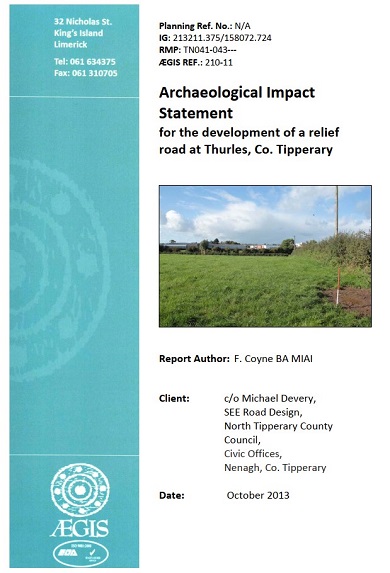
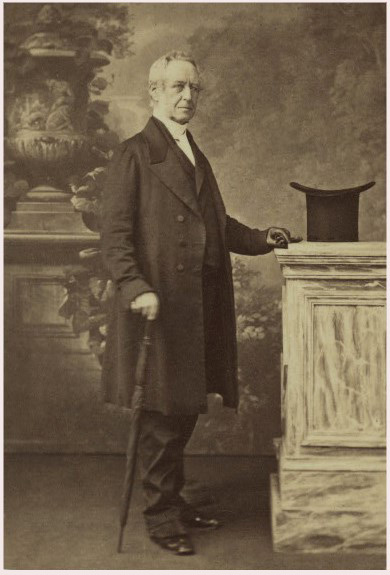
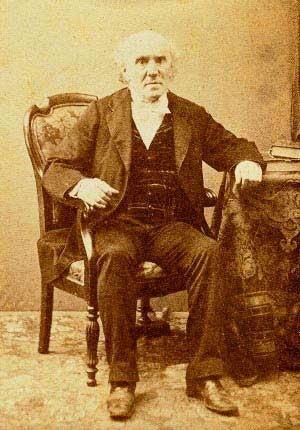

Pingback: Two Men Murdered Near Holycross County Tipperary | Thurles Information